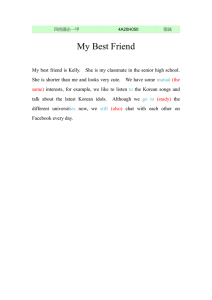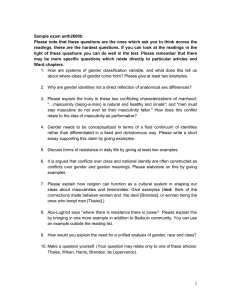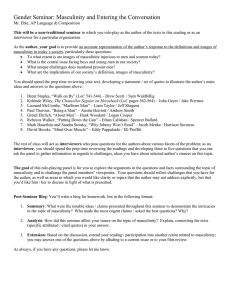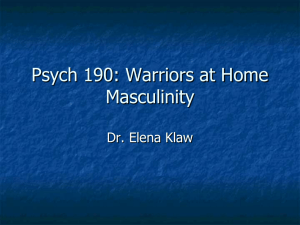Bao Chau Nguyen NCKH British K-pop fan’s attitudes toward the conventional beauty standards of K-pop male idols
advertisement
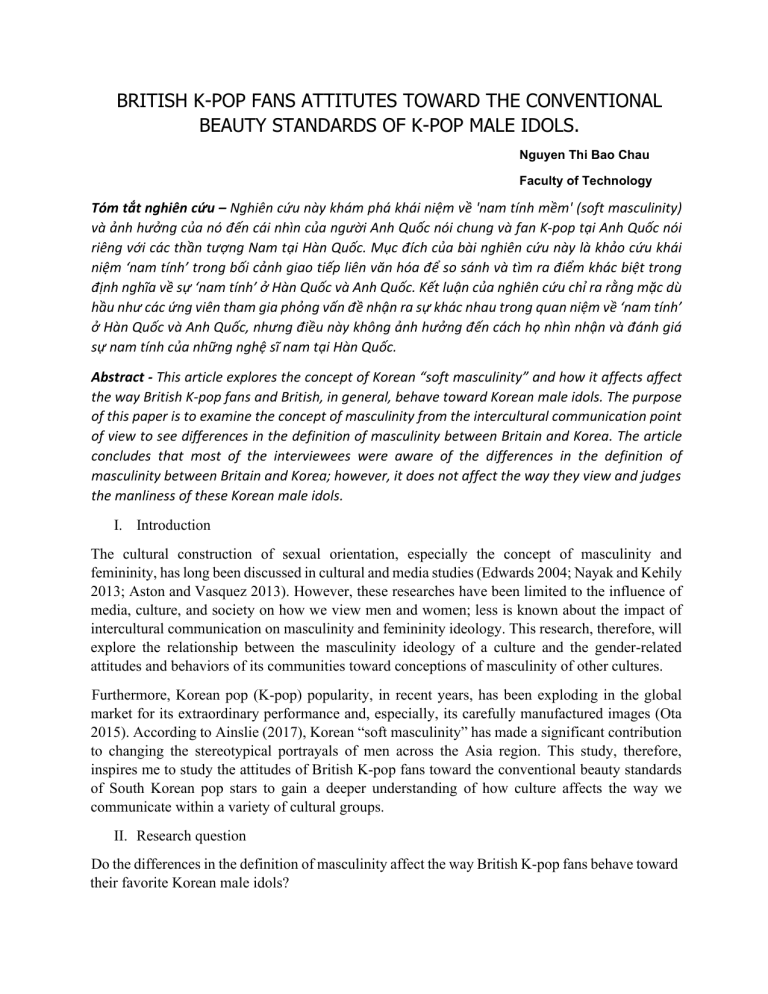
BRITISH K-POP FANS ATTITUTES TOWARD THE CONVENTIONAL BEAUTY STANDARDS OF K-POP MALE IDOLS. Nguyen Thi Bao Chau Faculty of Technology Tóm tắt nghiên cứu – Nghiên cứu này khám phá khái niệm về 'nam tính mềm' (soft masculinity) và ảnh hưởng của nó đến cái nhìn của người Anh Quốc nói chung và fan K-pop tại Anh Quốc nói riêng với các thần tượng Nam tại Hàn Quốc. Mục đích của bài nghiên cứu này là khảo cứu khái niệm ‘nam tính’ trong bối cảnh giao tiếp liên văn hóa để so sánh và tìm ra điểm khác biệt trong định nghĩa về sự ‘nam tính’ ở Hàn Quốc và Anh Quốc. Kết luận của nghiên cứu chỉ ra rằng mặc dù hầu như các ứng viên tham gia phỏng vấn đề nhận ra sự khác nhau trong quan niệm về ‘nam tính’ ở Hàn Quốc và Anh Quốc, nhưng điều này không ảnh hưởng đến cách họ nhìn nhận và đánh giá sự nam tính của những nghệ sĩ nam tại Hàn Quốc. Abstract - This article explores the concept of Korean “soft masculinity” and how it affects affect the way British K-pop fans and British, in general, behave toward Korean male idols. The purpose of this paper is to examine the concept of masculinity from the intercultural communication point of view to see differences in the definition of masculinity between Britain and Korea. The article concludes that most of the interviewees were aware of the differences in the definition of masculinity between Britain and Korea; however, it does not affect the way they view and judges the manliness of these Korean male idols. I. Introduction The cultural construction of sexual orientation, especially the concept of masculinity and femininity, has long been discussed in cultural and media studies (Edwards 2004; Nayak and Kehily 2013; Aston and Vasquez 2013). However, these researches have been limited to the influence of media, culture, and society on how we view men and women; less is known about the impact of intercultural communication on masculinity and femininity ideology. This research, therefore, will explore the relationship between the masculinity ideology of a culture and the gender-related attitudes and behaviors of its communities toward conceptions of masculinity of other cultures. Furthermore, Korean pop (K-pop) popularity, in recent years, has been exploding in the global market for its extraordinary performance and, especially, its carefully manufactured images (Ota 2015). According to Ainslie (2017), Korean “soft masculinity” has made a significant contribution to changing the stereotypical portrayals of men across the Asia region. This study, therefore, inspires me to study the attitudes of British K-pop fans toward the conventional beauty standards of South Korean pop stars to gain a deeper understanding of how culture affects the way we communicate within a variety of cultural groups. II. Research question Do the differences in the definition of masculinity affect the way British K-pop fans behave toward their favorite Korean male idols? III. Literature review 1. Masculinity from the intercultural communication point of view The definition of masculinity has been the subject of debate among academic disciplines and culture scholars for a long time (Jandt and Hundley 2007). However, for the study purpose, this paper will only look at the history of masculinity from the intercultural communication point of view. In the article named “Intercultural Dimensions of Communicating Masculinities”, Jandt and Hundley (2007) argues that the concepts of masculinity vastly “differ among cultures, including time, location, ethnicity, and sexual orientations”. It means that the definitions of ‘masculinity’ are quite diverse and can be affected by several factors including intercultural communication. Hare-Mustin and Marecek (1988) in “The Meaning of Difference: Gender Theory, postmodernism, and Psychology” also suggest that “most human sex-linked behavior is learned” which means that the way people view men and women can be affected by communication activities. 2. Flowerboys and Korean “soft masculinity” In the book “Korean Masculinities and Transcultural Consumption”, Jung (2011) argues that, contrary to the tough guy images in gangster and detective films in the 80s and 90s, the media representations of men after the mid-1990s in South Korea are a lot ‘softer’. She goes so far as to suggest that the pretty boy images or so-called ‘kkonminam’ (literally, ‘men beautiful like flower’) represent a new kind of masculinity in South Korean contemporary music. Arambam (2019) even goes further to describe the two main characteristics of the ‘kkonminam’ phenomenon as being excessively concerned with looks1 and not being afraid to show cute expressions and emotional sides. Therefore, with an aim to study intercultural effects on the definition of masculinity in the British K-pop fan community, this paper will focus on these two factors and use them as a guide to design the online interview questions (see appendix A). However, it is admitted that ‘soft masculinity’ is not the only media representation of Korean men nowadays. There are a lot more ideals of manliness in Korea modern society such as hegemonic masculinity (Park 2007; Kim 2014), global masculinity (Jung 2011), corporate masculinity (Elfving Hwang 2017), and superman masculinity (Praptika 2016). Nevertheless, due to the time constraints, this study chooses to focus on ‘soft masculinity’ as it has drawn a stark contrast with the well-muscled masculinity in the West (Park 2007). IV. Research Methodology To study the behaviors and beliefs of a community in its natural environment, an ethnographic approach is used in this research as its method and data collection techniques enable the researcher to avoid biased questions and improve the credibility of the data (LeCompte and Schensul 2010; Riemer 2012). 1 K-pop artists not only using make-up for the live broadcasting but also using skin care product for their daily life; and they are also fashionably dressed (Hwang 2011). A theory-testing approach is also used to support the application of a semi-structured interview as it gives the researcher a lot of useful information to set up an in-depth and open-ended interview to address the ways in which the stereotyped portrayal of British men affects British K-pop fan’s behavior toward K-pop male idols. The dataset includes personal information such as age, gender, job, the participant’s engagement with K-pop culture, their definition of ‘masculinity’, their opinion toward the appearance of K-pop male idols, and how they reflect K-pop beauty standards in their daily life (see appendix A). The online interview was conducted via Facebook Messenger and WhatsApp for approximately 20 minutes and was recorded by the researcher’s mobile phone. It is worth noting that, due to the anticipation of the stay-at-home orders and quarantines of COVID-19, the researcher was forced to do an online interview. As a result, the researcher was unable to observe the participants in their daily life activities. Therefore, to make sure the data collection is accurate and to avoid untruthful answers from the participants, an online observation guide is used to analyze the verbal behavior of participants during the online interview to support the data analysis (see Appendix B). Participant profiles In this research, seven British K-pop fans (2 males, and 5 females) who currently live in the United Kingdom (see Appendix E for the participant profiles) were analyzed. The fans had been interested in K-pop for between 1 year to 8 years which means the research had a wide range of fan engagement with K-pop culture when comparing the influence of K-pop culture on them. All of the participants were recruited through a participant recruitment form which was posted on 3 different groups for British K-pop fans on Facebook2 (see Appendix C). The majority of participants were students from 22 to 33 years old (4 undergraduate students, 2 postgraduate students, 1 freight forwarder). The overwhelming demographic of the participants is students might possibly be because K-pop is more popular with the young generation (Kim 2017). V. Findings Overall, most of the interviewees were aware of the differences in the definition of masculinity between Britain and Korea; however, it does not affect the way they view and judges the manliness of these Korean male idols. Some respondents even confess that they tend to focus on the music rather than the appearance of these Korean male idols. Interestingly, the more these British K-pop fans engage with K-pop culture the more they are open-minded about Korean ‘soft masculinity’. 1. Korean male idols defy the visual stereotypes of British masculinity 1.1. Soft masculinity Generally, more than half of interviewees (n = 4) responded that they feel K-pop male idols, in general, look more feminine than the stereotype of Western masculinity. During the online 2 Namely: KPOP UK, BU KPop Society 19/20 and Kpop Fans UK. interview, a lot of time, they used words to describe a woman when describing K-pop male idols such as “baby-faced”, “pretty”, “well-dressed”, “innocent”. These findings further support Jung’s (2011) work saying that ‘soft masculinity’ is the most common man’s image in the Korean contemporary music industry. “They have a very unique style, I mean, different to… what is considered to be the popular Western male look. The main thing that stands out in their look is the baby-faced look and the make-up, which isn't really popular on Western platforms. I think that people would traditionally consider this to be a 'feminine' appearance, I know growing up at schoolboys were made fun of for looking young or being interested in feminine things such as makeup so I think for some people it might not be a look that is popular in the UK.” – Interviewee 7. From this sample answer of interviewee number 7, we can further note that there is a gap between the conventional beauty standards of men between Britain and Korea which happens because some characteristics of Korean male idols such as fresh youthful faces and make-up are thought to be too feminine for man in British traditional society. The minority (n = 2), who were unsure about their answer whether K-pop male idols look more feminine or masculine, all agreed that K-pop male idols did have feminine traits. Evidence can be seen in the sample answer below: “I think to what people think, the rest of the world, of what a man looks like. I mean a lot of time, they (K-pop male idols) wear make-up then people can see it as being more feminine, but I wouldn’t really say that because a lot of time, you look at them, they are generally … like they are jacking (a freestyle dance move), they look quite masculine even though they are, sometimes, having feminine traits, like make-up, you know… like that.” – Interviewee 5. Among seven participants of the research, there was only one interviewee (Interviewee 1) who said that K-pop male idols look manly, he stated: “I would say they are masculine”. However, after analyzing his verbal and non-verbal behavior during the interview as follow the online observation guidance, we suggest that this answer is unreliable as the participant was uncertain about his answer and he, then, explained that “I don’t really pay attention to what they look like”. In conclusion, most respondents were aware of the softer masculinity of Korean male idols compared to the Western traditional stereotype of manliness. 1.2. Heavy makeup looks In many countries, a man wearing make-up on the street might feel uncomfortable because of the unwelcome glares from other people toward his manliness or even his gender. However, in South Korea, it is totally normal to do so as Korea is so used to the image of K-pop male idols wearing heavy make-up on stage. In the United Kingdom, on the other hand, it does not seem to be that normal for a manly man to wear make-up on the street. One male participant strongly stated that: “I would probably say... For me, personally, a guy who uses makeup is not a real man. Too girly. But men are becoming more and more girly. So that's probably normal now.” – Interviewee 4. From the statement above, we suggest that, in British culture, make-up is subconsciously noted as a sign of femininity. Despite the fact that all of the participants (n = 7) agree that make-up can be worn by any gender, there are still some people (n = 4) concerned that wearing make-up might affect a man’s masculinity. Evidence can be seen in one sample answer as below. “Personally, I think make-up can be worn by any gender and it shouldn’t affect ‘masculinity’, but I think more generally in society it would be perceived as less masculine to wear makeup.” – Interviewee 6. Interestingly, for those participants (n = 2) who have more than 7 years of experience been a Kpop fan, they seem to be more open-minded about Korean men's beauty culture. Take interviewee number 5 for example: “Not at all. I think it isn’t enhancing anything, you know. A lot of … I think it is better that K-pop idols are more honest about the fact that they are wearing make-up. Everyone, like every man, in UK and America and stuffs they still wear makeup on TV, it just they just don’t talk about it. Whereas, you know … I think for me it is more attractive that guy, is like … okay with wearing make-up and kinds of stuff. It doesn’t take away from their masculinity, I think. They just enhancing what they had.” – Interviewee 5. Different from the two previous answers (which were from the two K-pop fans who have less than 2 years of experience with K-pop), it is seen that this statement (from interviewee 5) goes beyond the gender equality point of view to encourage every man to wear make-up. Consequently, it shows a possibility that K-pop beauty standards (in particular: make-up) can affect British fans’ attitudes toward British traditional beauty standards of what is called masculinity. 1.3. Acting cute and adorable There are a few respondents (n = 3) who relate the cute actions of K-pop male idols with Britain feminine traits; others (n = 4), however, think that they are so used to K-pop culture that it does not affect them in such a way. For those who see cute actions as being feminine, they explained that, in British society, particularly in the past, masculinity was defined by a man’s physical and emotional strength, which was perceived to be beneficial in order to 'protect' and 'look after' a woman which is obviously coming from a patriarchal and sexist origin. Therefore, a male who acts cute and adorable is considered to be weaker and more feminine. Evidence can be seen below: “I think cute is traditionally a trait associated with females and femininity due to the caring and nurturing nature of a female and her role as a mother. I think traditionally, western males dislike being associated with being 'cute' and 'adorable' due to them being reserved as feminine descriptors and that having such descriptions attached to themselves diminishes their masculinity. I think also they're traditionally words reserved for maybe describing children, I think in terms of masculinity this association is traditionally going to make a male seen as weak, as less of a man maybe. I think the rejection of having association with such words all stems from the traditionally patriarchal society, with males as the head of the household and the powerful figures in society, once again that femininity and females are weaker or lesser than males. I think by acting 'cute' and not tough and strong, it opens a male up to be seen with more vulnerability, which isn't a bad thing, but does not conform to traditional societal gender roles.” – Interviewee 7. Again, we will see a big difference in the way a 1-year K-pop fan and an 8-year Kpop fan view the same problem as below: […] “Because I feel like, it just differs from what… you know, the society said a man should be. But someone looking cute or you know, someone doing something to please someone else, especially the friendship that they had … Like, I think it doesn’t take away any masculinity of a person. I think some people can see it that way just because of, you know, what society says, you know, this is what a man should be. But for me, it doesn’t take away anything. I think as long as they see themselves as a man, see themselves manly.” – Interviewee 5 For this respondent, it is suggested that she is aware of the fact that the British traditional idea of masculinity is differ from the norm of Korean male behaviors. However, she seems to not agree with this traditional point of view. For the purpose of this assignment, we will not go too far to explain the reason why she is opposed to the British traditional idea of masculinity. Due to the small scale of the research, we will just suggest that it might be affected by K-pop culture through intercultural communication activities. Further studies and research are needed to confirm this theory. 2. Appearance does not make a Man a Man In the previous parts, we discussed the attitudes of British K-pop fans toward the conventional beauty standard of K-pop male celebrities. It can be seen that British K-pop fans are aware of the differences in the masculinity ideology between the two cultures and it does not seem to affect their love and support toward K-pop male idols. However, during the interview, the researcher realizes an interesting fact that in most of the respondent’s minds (n = 6), masculinity is not directly linked with appearance. […] “I think it is less to do with appearance and it is more about actions.” – Interviewee 1 “In our days, manly man in Europe is probably half naked with six pack and huge muscles… Honestly, I think a real man should still take care of himself in terms of health, that includes that he shouldn't be overweight, have an illness and not do anything about that, etc.” – Interviewee 4. Interviewee 5 even strongly claims that wearing a dress does not make a man look less manly, it is his behaviors and attitudes that make him look masculine. “Um, … manly is properly … I think more like confidence… I don’t know I think confidence makes a man look manly. I mean I have seen some K-pop idols in a dress and some women say that it is the most masculine thing in the world *laugh*. You know… I don’t know if you have seen Jackson was running around in a dress, he still quite masculine, the way he acts was quite masculine.” – Interviewee 5. VI. Conclusion All things considered, research has long shown that there is a big difference in the definition of masculinity between Britain and Korean cultures. During the intercultural communication activities through K-pop fan activism, the conventional beauty standard of Korean male idols has moved from Korea to Britain and effect British K-pop fans. It is evidence that the more British K-pop fan engages with K-pop culture, the more they are open-minded about K-pop soft masculinity. However, due to the small scale of the sampling in this research, further studies are needed to test the theory on a larger scale. References Ainslie, M. J., 2017. Korean Soft Masculinity vs. Malay hegemony: Malaysian masculinity and Hallyu fandom. Korea Observer [online], 48(3), 609-638. Andermann, L., 2010. Culture and the social construction of gender: Mapping the intersection with mental health. International Review of Psychiatry [online], 22(5), 501-512. Arambam, T. D., 2019. Transition of the idea of masculinity in k-pop culture within Indian viewers. International Journal of Multi-Disciplinary Research [online], 4(2). Aston, J.M. and Vasquez, E., 2013. Masculinity and femininity: stereotypes/myths, psychology and role of culture [online]. Hauppauge, N.Y: Nova Science Publishers. Crane, D., 2000. Fashion and Its Social Agendas: Class, Gender, and Identity in Clothing [online]. Chicago: The University of Chicago Press. Edwards, T., 2004. Cultures of Masculinity [online]. London: Routledge. Elfving-Hwang, J., 2011. Not So Soft After All: Kkonminam Masculinities in Contemporary South Korean Popular Culture. KSAA 7th Biennial Conference: 16-18 November 2011, Sydney, Australia. Sydney: The Korean Studies Association of Australasia (KSAA). Available from: https://www.academia.edu/22503546/Not_So_Soft_After_All_Kkonminam_Masculinities _i n_Contemporary_South_Korean_Popular_Culture [Accessed 21 May 2020]. Elfving-Hwang, J., 2017. Aestheticizing Authenticity: Corporate Masculinities in Contemporary South Korean Television Dramas. Asia Pacific Perspectives [online], 15(1), 55-72. Francis, M., 2002. The Domestication of the Male? Recent Research on Nineteenth- and Twentieth-Century British Masculinity. The Historical Journal [online], 45(3), 637-652. Gauntlett, D., 2008. Media, Gender and Identity: An Introduction [online]. 2nd edition. London: Routledge. Hare-Mustin, R. T. and Marecek, J., 1988. The meaning of difference: Gender theory, postmodernism, and psychology. American Psychologist [online], 43(6), 455-464. Jandt F, Hundley H. Intercultural Dimensions of Communicating Masculinities. Journal of Mens Studies [online], 15(2):216-231. Jandt, F. and Hundley, H., 2007. Intercultural Dimensions of Communicating Masculinities. Journal of Men’s Studies [online], 15(2), 216-231. Jung, S., 2011. Chapter 2: Bae Yong-Joon, Soft Masculinity, and Japanese Fans: Our Past Is in Your Present Body [online]. In: Jung, S., ed. Korean Masculinities and Transcultural Consumption: Yonsama, Rain, Oldboy, K-Pop Idols. Hong Kong: Hong Kong University Press, 35-72. Jung, S., 2011. Chapter 3: Rain, Global Masculinity, and Singaporean Fans: Fly Anywhere, Click Anytime. [online]. In: Jung, S., ed. Korean Masculinities and Transcultural Consumption: Yonsama, Rain, Oldboy, K-Pop Idols. Hong Kong: Hong Kong University Press, 73-118. Jung, S., 2011. Chapter 5: K-Pop Idol Boy Bands and Manufactured Versatile Masculinity: Making Chogukjeok Boys [online]. In: Jung, S., ed. Korean Masculinities and Transcultural Consumption: Yonsama, Rain, Oldboy, K-Pop Idols. Hong Kong: Hong Kong University Press, 163-170. Kim, A., 2017. Korean Popular Music (K-Pop), Youth Fan Culture, And Art Education Curriculum [online]. Thesis (Master). University of South Carolina. Available from: https://scholarcommons.sc.edu/cgi/viewcontent.cgi?article=5385&context=etd [Accessed 20 May 2020]. Kim, M., 2014. South Korean Rural Husbands, Compensatory Masculinity, and International Marriage. The Journal of Korean Studies (1979) [online], 19(2), 291-325. Kimmel, M. S., 2005. From Lord and Master to Cuckold and Fop: Masculinity in 17th-Century England [online]. In: Kimmel, M. S., ed. The history of men: essays in the history of American and British masculinities. Albany: State University of New York Press, 125-142. Lease, S. H., Montes, S. H., Baggett, L. R., Sawyer, R. J., Fleming-Norwood, K. M., Hampton, A. B., Ovrebo, E., Ciftci, A. and Boyraz, G., 2013. A Cross-Cultural Exploration of Masculinity and Relationships in Men from Turkey, Norway, and the United States. Journal of CrossCultural Psychology [online], 44(1), 84-105. LeCompte, M. D. and Schensul, J. J, 2010. Designing & conducting ethnographic research: an introduction [online]. 2nd edition. Lanham: AltaMira Press. Monocello, L.T. and Dressler, W.W., 2020. Flower boys and muscled men: comparing South Korean and American male body ideals using cultural domain analysis. Anthropology & Medicine [online], 27(2), 176–191. Nayak, A. and Kehily, M.J., 2013. Gender, youth and culture: global masculinities and femininities [online]. 2nd edition. Basingstoke, Hampshire: Palgrave Macmillan. Park, R., 2007. Muscles, symmetry and action: “do you measure up?” defining masculinity in Britain and America from the 1860s to the early 1900s. International journal of the history of sport [online], 24(12), 1604-1636. Park, S. M., 2007. Dual Dominating Strategies of the Korean Hegemonic Masculinity: Advertisements for Men’s Cosmetics [online]. American Sociological Association Annual Meeting 2007, New York, 11-14 August 2007. New York: American Sociological Association. Available from: https://eds-b-ebscohost com.libezproxy.bournemouth.ac.uk/eds/pdfviewer/pdfviewer?vid=1&sid=3dd77bc6f2cb 462a-92fe-e6c5795d91ff%40sessionmgr103 [Accessed 20 May 2020]. Riemer, F.J., 2012. Chapter 7: Ethnographic research. In: Lapan, S. D., Quartaroli, M. T., Riemer, F. J., eds. Qualitative Research: An Introduction to Methods and Designs. San Francisco: Jossey-Bass, 163-188. Woodin, J., 2016. How to research Interculturally and Ethically. In: Hua, Z., ed. Research methods in intercultural communication: a practical guide. Hoboken: Wiley-Blackwell.
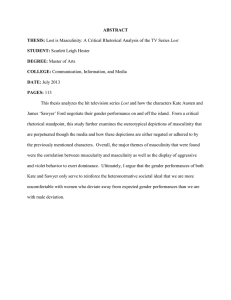
![C-SWIR Seminar Promo: 26oct2015 [DOC 143.50KB]](http://s2.studylib.net/store/data/014974093_1-9ff6fa79b7dfcfba164f1f275834567b-300x300.png)
